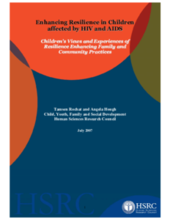The province of KwaZulu-Natal is particularly hard hit by HIV and AIDS as a result of high prevalence coupled with high levels of poverty and low levels of service reach and resources in relation to other provinces in the country. In such communities, children face multiple risk factors to their healthy development due to the impact of HIV and AIDS and poverty. HIV and AIDS can render children vulnerable in a multitude of ways, including placing them at increased risk of experiencing negative life events, exposing them to increased poverty, losing their parent and other significant adults, dropping out of school and being excluded from other social networks and processes. What is clear at this point in the epidemic is that there are not likely to be any quick solutions. While addressing widespread poverty, and improving social protection, treatment and prevention in the longer term, it is also vital that we work to enhance children’s, families’ and communities’ resilience in the face of such adversity.
While considerable effort has been invested in research which examines maladaptive behaviours resulting from high exposures to risk situations, it is equally valuable to explore the mechanisms by which some children come through high risk situations exhibiting adaptive behaviours. Given that children affected by HIV and AIDS face a multitude of risks, the examination of resilience offers an important opportunity to guide prevention and intervention programming aimed at improving children’s lives. At this point in the epidemic, while the majority of children remain in school and families are able take in children the opportunities to better understand resilience at both a child and family level are abundant. It is also a time when child rights-based approaches convince us of the need to seek out ways to engage and empower children and families as agents of change in a world of HIV and AIDS.
The focus of this qualitative research was to explore children’s experiences of family and community practices which children perceive to enhance their resilience. The study explores the extent to which local existing cultural practices and relationships offer opportunities to build children’s resilience prior to, during and after loss, crisis or adversity. The study adopts a developmental approach and examines children’s experience over a range of age groups and uses methodology aimed at facilitating real life, meaning-laden data in participation with children.
The report provides a framework against which to understand resilience by providing a short overview of important research evidence on risk and resilience. It describes approaches which have been developed to understand and enhance resilience outside of the context of HIV and AIDS in order to explore possibilities of useful applications to the field of children and HIV and AIDS. The overview explores the contextualised nature of resilience in childhood, making a strong argument for the use and application of participatory research with children and the invaluable contribution it can make in understanding the needs of children and communities affected by HIV and AIDS. Thereafter the report provides a discussion of the findings of the research and the experience of children of different ages through the categories of people, places, practices and programmes. Comparisons are made between the existing evidence on resilience and the voices of the children participating in this study – and conclusions are drawn regarding the implications for both practice and research.
Recommendations are made for framing responses in the form of external support to people, places, practices and programming which could enhance and support the resilience of children, families and communities. These are summarised below.
Inventions in support of people: A stable and consistent, responsive care giver or the presence of a replacement caring adult who will champion for the child, invest in the child’s future and have hope for them is one of the clearest mechanisms for enhancing resilience, both from the literature and the children’s data. Two ways in which building resilience can be supported is through support and training of replacement care givers and the development of friendship and peer support networks.
Interventions in support of places: Crime and other threats related to place are linked to poverty and disrupted social structures in communities; these require both intervention and prevention efforts. Schools are an investment in children’s future and provide children with support and structure. They offer the advantage of a fixed framework within which resources can be invested and monitored in order to assist children. The literatures as well as children’s voices indicate that schools are an important source of assistance to children.
Intervention in support of practices: While the epidemic seems overwhelming, what is clear in both the literature and the children’s data is that caring consistent everyday practices contribute tremendously to helping children cope and build resilience. In many respects, understanding the importance of everyday practices opens an opportunity to take small and approachable steps towards helping children. More importantly it provides a clear set of interventions ideas with which families and other community members can engage. This provides an opportunity to support and encourage community members to feel valued in the care of their own children.
Interventions in support of programmes: The sheer extent of the epidemic requires that all communities, starting from small units of care, such as families but extending to external support organisations, civil society, government and the international community need to invest in ways to bring children into a new hopeful era. These investments in community need to be integrated, use resources effectively and be thoughtful and sustainable if they are to hold value for children in the longer term and build resilience in the shorter and medium term.
©Human Sciences Research Council

